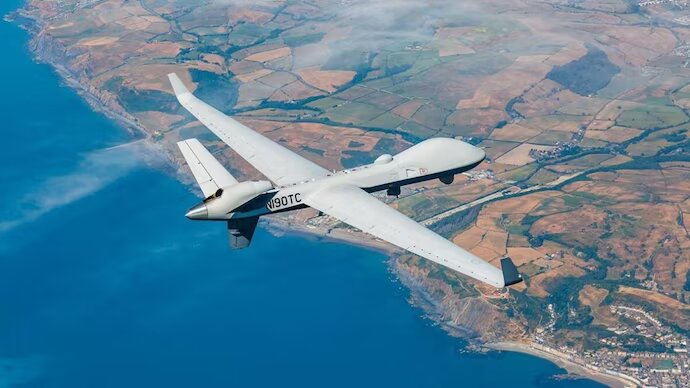India’s Defense Acquisition Council (DAC) gave the go-ahead to buy US-made Predator drones, which are probably the best in the world, last week. India will pay about $3.5 billion for 31 Predator-B drones that can fly high and stay in the air for a long time. India already has two Sea Guardian drones, which are like the dangerous Predator series but don’t have weapons.
What are Predator Drones?
General Atomics, a defense contractor in San Diego, made the Predators, which are thought to be the best in the game. One of these drones, which were mostly made for spying purposes, found Osama bin Laden in Afghanistan in the year 2000.
After that, deadly Hellfire missiles were added to Predator drones that were made to be armed. With constant changes and updates, the predators of today are much better than the ones that came before.
These drones can fly up to 50,000 feet high for more than 27 hours and can carry up to 1,746 kg. The Times of India said that India is interested in the MQ-9B SkyGuardian and MQ-9B SeaGuardian versions of these drones. These drones are meant to work via satellite and can fly for more than 30–40 hours. These drones can fly in any kind of weather and can carry more than 2,000 kg.
Predator drones operational history: A brief
Since 1995, when they were first used by the American military, Predator drones have been used a lot in the war zone. The first time the Predator was used was over Bosnia in the summer of 1995. In August 1997, General Atomics was given the first contract for a run of productions.
Later, it was used to help with operations in Afghanistan, Iraq, Yemen, Libya, Somalia, and Syria. Predator drones have made a name for themselves because they have been used a lot and worked well in war zones. So far, nothing has come close to Predators when it comes to unmanned attack.
Other drones in the world
Even though American Predator drones are the best drones on the market, other countries are also making progress on their own robotic aerial vehicles (UAV).
Israel’s Elbit Hermes 450: It is an attack UAV that has two Hellfire missiles on board. It can be used for reconnaissance, surveillance, and relaying messages for more than 20 hours. The United States also runs these drones.
Turkey’s Bayraktar drones: Turkey has made a lot of progress in making drones. Its Bayraktar drones became famous after Ukraine used them to lock in on Russia’s land-based targets, which were destroyed seconds after they were locked.
The Bayraktar can carry laser-guided weapons and its body is small enough to fit on a truck. Most importantly, they are much cheaper than American Predator drones. The drone has been sold to 13 countries, and it is said that it can change the way wars go.
When Azerbaijan and Armenia fought over Nagorno-Karabakh in 2020, these same drones were used to decide the outcome of the war.
Where does India stand in the drone race?
India knows that drones are a key part of modern fighting, but it hasn’t done much to improve its own drones. A KPMG study said that startups in the country are working on developing and finding new applications and use cases for drones. This is because the drone industry is getting more attention again.
The Centre is very interested in improving the local knowledge of drone technology, and its open policies and other programs like drone shakti are helping the market grow, the study said. Drone Shakti is an incentive program that is tied to output and is meant to help domestic drone development.
DRDO Rustom
The Defense Research and Development Organisation is making the DRDO Rustom, an unmanned air vehicle (UAV) that can fly for a long time at a medium level. It was based on the National Aerospace Laboratory’s (NAL) LCRA (Light Canard Research Aircraft), which was created in the 1980s by a team led by the late Prof. Rustom Damania.
The Rustom will come in three different versions. The Rustom-1 is a combat UAV that can stay in the air for 12 hours.
The second is Rustom-H, which is a bigger UAV that can fly for more than 24 hours and has a longer range and higher service level. The service ceiling of an air vehicle is the highest point it can reach.
The third will be a UAV based on Rustom-H called Rustom-2 (TAPAS-BH-201). It is being made in the same way as the MQ-1 Predator by General Atomics. In November 2016, it made its first flight.
